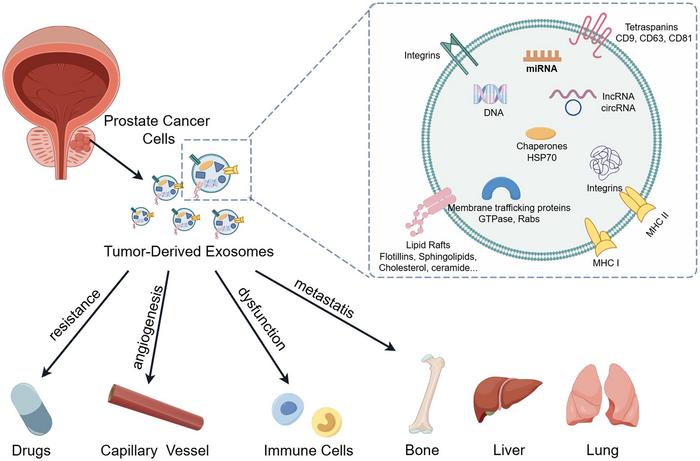
Prostate cancer remains a formidable challenge in oncology, ranking among the most prevalent and deadly malignancies globally. One of the persistent issues in managing this disease lies in the early detection and treatment of aggressive forms without subjecting patients to unnecessary invasive procedures or overtreatment. Traditional diagnostic tools, such as prostate-specific antigen (PSA) testing, have transformed screening practices but are hampered by low specificity, often triggering a cascade of biopsies and procedures that carry their own risks. In the quest for more precise, minimally invasive diagnostic and monitoring modalities, scientists are turning their attention to exosomes—nanoscale extracellular vesicles that promise to revolutionize prostate cancer care by enabling liquid biopsies that pierce the veil of tumor biology with unparalleled sensitivity and specificity.
Exosomes are lipid-bilayer vesicles, typically ranging from 30 to 150 nanometers in diameter, secreted by virtually every cell in the body. Their biogenesis involves the inward budding of endosomal membranes to form multivesicular bodies that eventually fuse with the plasma membrane, releasing exosomes into the extracellular environment. Critically, these vesicles encapsulate a rich cargo of bioactive molecules including DNA fragments, messenger RNAs, microRNAs (miRNAs), long noncoding RNAs (lncRNAs), circular RNAs (circRNAs), proteins, and lipids. The molecular composition of exosomes mirrors the physiological or pathological state of their cells of origin, making them a treasure trove of biomarkers that can be non-invasively harvested from bodily fluids such as blood, urine, and prostatic secretions.
The narrative of exosomes in prostate cancer is layered and transformative. Tumor-derived exosomes play instrumental roles in supporting cancer’s hallmark traits: facilitating drug resistance, modulating the tumor microenvironment, evading immune destruction, and enhancing metastatic cascades. For instance, exosomal miRNAs contribute to epithelial-mesenchymal transition (EMT), a process integral to cancer invasion and dissemination. One example is miR-95, delivered by tumor-associated macrophage-derived exosomes, which targets and downregulates JunB, a transcription factor with implications in tumor suppression, thereby enhancing the metastatic potential of prostate cancer cells.
Beyond their pathological roles, exosomes open new horizons for diagnosis. PSA testing, despite its widespread use, suffers from several technical limitations and lacks the precision to discriminate between indolent and aggressive tumors. Exosomal biomarkers present a powerful alternative, capitalizing on their ability to encapsulate tumor-specific nucleic acids and proteins that can be isolated from non-invasive liquid biopsies. Specific miRNAs such as miR-19b-3p and miR-101-3p have emerged as promising candidates for distinguishing metastatic prostate cancer from localized disease. Additionally, proteomic profiling of exosomes reveals elevated levels of prostate-specific membrane antigen (PSMA) and caveolin-1, proteins overexpressed in malignant tissues but not in benign prostatic hyperplasia, which offers a functional biomarker platform surpassing PSA’s limitations.
The diagnostic precision is further enhanced by leveraging urinary long noncoding RNAs, which outperform PSA in detecting clinically significant cancers. Clinicians and researchers are increasingly appreciating that panels combining multiple biomarkers—such as miR-141-3p and miR-125a-5p—yield greater specificity and sensitivity, reducing the volume of unnecessary biopsies and the psychological burden on patients. This multiparametric approach anchored in exosomal biology may herald a new era of precision diagnostics tailored to the molecular fingerprint of each patient’s tumor.
A remarkable aspect of exosomes lies in their dualistic role in treatment. On one hand, they contribute to drug resistance, a major roadblock in prostate cancer management, especially in treatment-resistant states such as castration-resistant prostate cancer (CRPC). Exosomes derived from cancer-associated fibroblasts (CAFs) shuttle miR-423-5p which downregulates GREM2 through TGF-β signaling pathways, thereby fostering resistance to taxane-based chemotherapy. Similarly, the long noncoding RNA ROR, carried via exosomes, activates the β-catenin/HIF1α feedback loop, attenuating the efficacy of docetaxel, a cornerstone chemotherapeutic agent in advanced prostate cancer.
Conversely, the inherent biocompatibility and cell-targeting capabilities of exosomes make them ideal vehicles for drug delivery. Researchers have engineered exosomes to ferry chemotherapeutic agents such as paclitaxel directly to tumor cells, improving drug bioavailability and minimizing systemic toxicity. Beyond chemotherapeutics, exosomes can encapsulate gene regulatory molecules like tumor-suppressive miRNAs (e.g., miR-let-7c), offering a sophisticated means of modulating gene expression within cancer cells. Innovative preclinical strategies employ exosomes loaded with inhibitors of TGF-β or agonists for toll-like receptors 7 and 8 (TLR7/8), leveraging these pathways to tip the balance towards antitumor immunity and tumor microenvironment remodeling.
Predicting prognosis is another frontier where exosomes exhibit commanding potential. Their cargo reflects metastatic competency and therapy responsiveness in ways that traditional clinical metrics cannot. For example, exosomal miR-500a-3p and the glycolytic enzyme PGAM1 promote angiogenesis and osteoblastic bone metastasis—hallmarks of advanced prostate cancer that dramatically affect patient survival. Long noncoding RNA HOXD-AS1, delivered via exosomes, drives metastasis through modulation of miR-361-5p and the transcription factor FOXM1, emphasizing the complex regulatory networks harnessed by exosomes in disease progression.
Clinically meaningful prognostic biomarkers also include miRNAs such as miR-150-5p and miR-1290. Decreased levels of miR-150-5p and increased miR-1290 in exosomes correlate consistently with poor overall survival in CRPC patients. Likewise, elevated exosomal miR-375 and miR-1275 are predictive of bone metastasis and therapeutic response, respectively, thereby furnishing oncologists with dynamic tools to tailor treatment regimens and monitor treatment efficacy in real-time.
Despite these compelling advances, the journey from bench to bedside is fraught with technical and clinical challenges. Isolation and purification of exosomes remain complex, with methods like ultracentrifugation being resource-intensive and lacking standardized protocols for ensuring purity and dosing consistency. Moreover, many promising biomarkers identified to date are based on small cohorts and preclinical studies, underscoring the urgent need for large-scale, multicenter clinical trials to validate candidates such as circTFDP2 and ZNF667-AS1.
Innovation continues unabated with potential breakthroughs on the horizon. Radiolabeled exosomes are being explored as novel imaging agents that could highlight metastatic niches with unprecedented sensitivity. Engineered vesicles tailored for site-specific drug delivery and immune modulation herald a future where exosome technology could transform prostate cancer therapeutics from a blunt instrument into a scalpel of precision medicine.
In conclusion, exosomes embody a paradigm shift in prostate cancer management. By encapsulating tumor-specific molecules in a naturally biocompatible and minimally invasive form, exosomes transcend the limitations of current diagnostic and therapeutic modalities. Their incorporation into clinical practice holds promise for earlier detection, sharper risk stratification, and the circumvention of drug resistance. Realizing this potential will require sustained multidisciplinary efforts spanning molecular biology, engineering, and clinical oncology. As we stand on the cusp of this new frontier, exosome-based liquid biopsies may soon redefine prostate cancer care, optimizing outcomes while minimizing harm for millions of patients worldwide.
Subject of Research: Exosomes as biomarkers and therapeutic vehicles in prostate cancer
Article Title: Exosomes: A Promising Tool for Liquid Biopsy in Prostate Cancer
News Publication Date: 25-Mar-2025
Web References: Cancer Screening and Prevention Journal
Image Credits: Yang Yu, Aixin Qiu, Zhen Luo
Keywords: Exosomes, Prostate cancer, Liquid biopsy, miRNA, lncRNA, circRNA, Drug resistance, Tumor microenvironment, Metastasis, Biomarkers
Tags: challenges in prostate cancer screeningearly detection methods for prostate cancerexosome biogenesis and functionexosomes as biomarkers in prostate cancerinnovations in cancer diagnosticsliquid biopsy advancements in oncologyminimally invasive cancer monitoring techniquesmolecular composition of exosomesnon-invasive diagnostic techniques for cancerprecision medicine in prostate cancer treatmentprostate-specific antigen testing limitationsrole of extracellular vesicles in cancer





